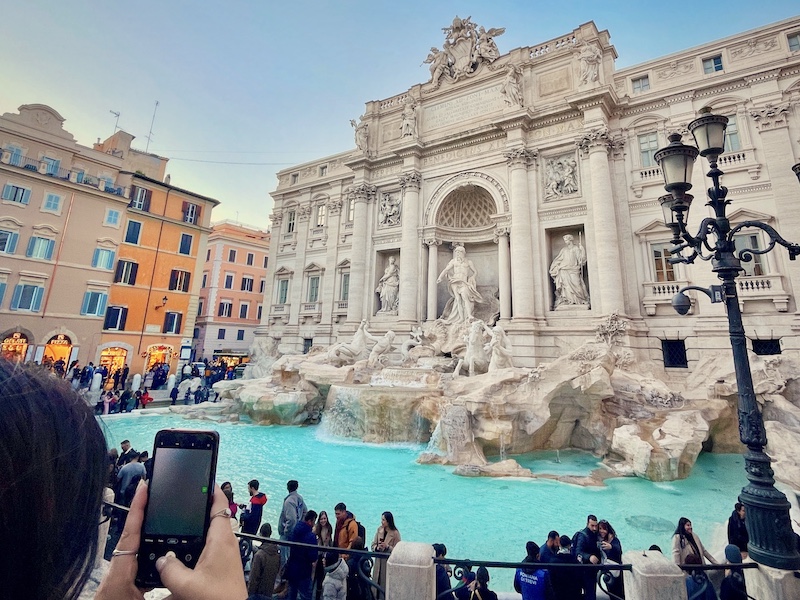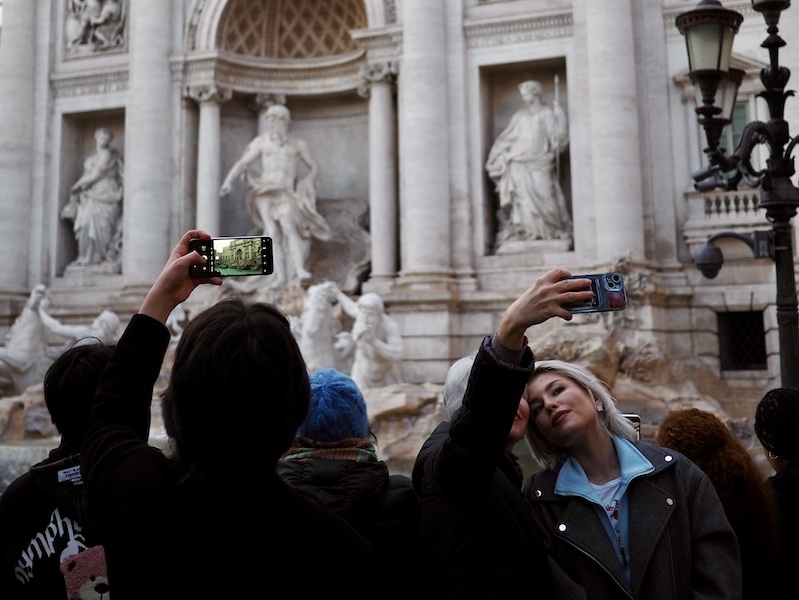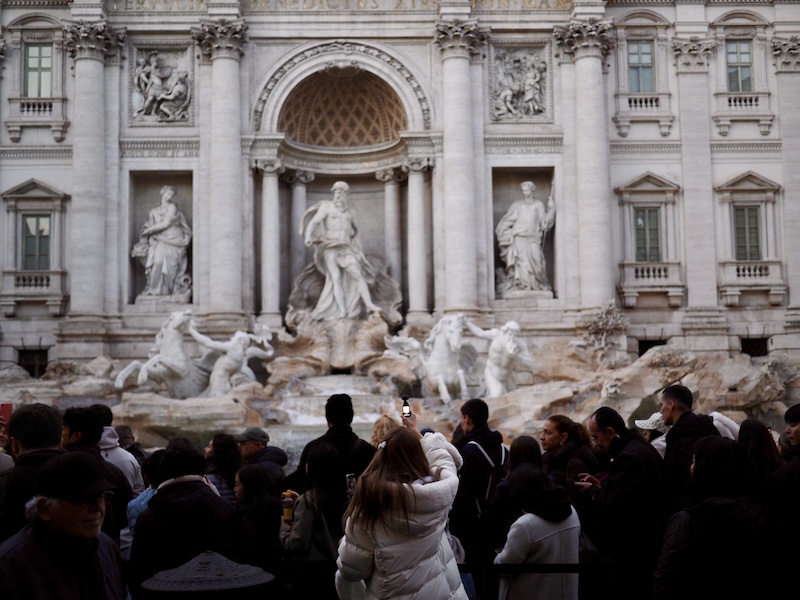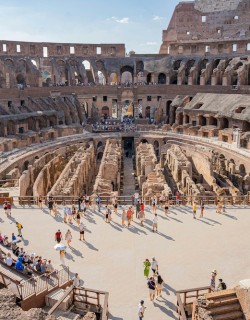There are some places in Rome you simply can’t afford to miss. One of the city’s absolute highlights is the Trevi Fountain, an awe-inspiring masterpiece of Baroque sculpture that is justly regarded as one of the world’s most beautiful monuments. After an in-depth cleaning and restoration in 2024, the scaffolding has come down and the Trevi has never looked so good - especially when illuminated by its state-of-the-art lighting system after dark. But how much do you really know about the Trevi? Read on for our guide to 7 things you need to know before you go! To plan your visit to the Trevi fountain, check out our in-depth pratical guide to the Trevi here.
1.The Trevi has been a Roman lifeline for 2,000 years
The magnificent Baroque fountain that brings visitors flocking from all round the world is just the latest chapter in the Trevi’s 2000 year history. Rome has always been a city of water, and the massive size of the ancient metropolis was only made possible because of the series of aqueducts that brought vast quantities of the stuff flowing into the urbs from the surrounding countryside.
One of the most important of these was the Aqua Virgo, constructed in 19 B.C. at the behest of the powerful Marcus Vipsanius Agrippa to supply the baths complex that bore his name, complete with ornamental canal and artificial lake. The Aqua Virgo was damaged by Gothic invaders in the 6th century after the fall of the Roman empire, and by the Middle Ages was a shadow of its former self.
It continued to bring a trickle of vital water to the city however, and a modest fountain was built at the aqueduct’s new terminus; over the centuries it acquired the name Trevi as it was located at the intersection of three ancient roads known as the trivium or tre vie (three roads).
2. The Trevi is Rome’s greatest open-air theatre of the Baroque

Restoring the city’s ancient water sources heralded Rome’s resurgence in the Renaissance after a millennium of decline, and the 15th-century architect Leon Battista Alberti helped renovate the aqueduct in 1453. In the centuries to come the sites where fresh water arrived in the city were ceremoniously marked with fabulously elaborate fountains. After doomed projects involving great artists such as Gianlorenzo Bernini and Pietro da Cortona came to nothing, in the 1730s Pope Clement XII finally hired the Roman architect Nicola Salvi to provide a fitting Baroque monument to showcase the now rechristened Acqua Vergine.
Salvi came up with a brilliant design that fused the massive classical façade of the Palazzo Poli behind with the new organic form of the immense fountain, a mountain of porous Travertine stone fully 86 feet high and 160 feet wide. In Salvi’s epic masterpiece of ancient mythology, the sea-titan Oceanus advances towards us from a central niche directing the flow of the gushing waters as seahorses and tritons cavort all around him, whilst fake cliffs tumble down from the palazzo and into the square below. This is the Baroque at its most dramatic.
3. 30 years of hurt: building the fountain was a dangerous business

Work on the fountain began in 1732, but the massively complex job was anything but plain sailing. The construction team suffered a laundry list of injuries, including three deaths – a stonecutter was crushed by a block of travertine, a mason fell off the roof, and an apprentice slipped and cracked his head on the marble. The fountain took 30 years to finish, and the fiercely committed Salvi sadly didn’t live to see his creation brought to fruition, dying in 1751. According to some, Salvi too fell victim to the fountain, succumbing to a respiratory disease after spending so many years inhaling stone dust on the building site.
4. The coin tossing tradition was invented by an eccentric intellectual

We all know the drill – turn your back, toss a coin into the Trevi fountain over your right shoulder, and one day you’ll be sure to return to the Eternal City. But although the tradition recalls ancient practices of burying coins into the foundations of wells, fountains and springs, it seems that the practice at the Trevi was actually invented by a German academic and guide by the name of Wolfgang Helbwig looking to spice up his tours in the late 19th century.
As a fitting conclusion to the cultivated jaunts he organised around the Eternal City for his northern guests, Helbwig decided to organise farewell banquets in front of the Trevi fountain. Searching for a dramatic culminating gesture to end the festivities, he instituted the pseudo-classical ritual in an effort to drum up repeat custom – it worked better than he could ever have imagined, and legions of tourists dump unimaginable quantities of small change into the fountain each week.
5. The Trevi is a goldmine for charities – and enterprising thieves
It’s estimated that more than 3,000 euros are thrown into the fountain each and every day – that’s upwards of a million euros per year. In an attempt to thwart enterprising thieves unable to resist the lure of such a haul, the coins are collected every night and donated to the Roman Catholic charity Caritas, who use the money to provide food for the city’s poorest residents. But in times past the bandits had the upper hand.
For more than 30 years Roberto Cercelletta, ironically known by Romans as d’Artagnan after the swashbuckling French musketeer, had been supplementing his income by extracting coins from the fountain every morning just before dawn with a special sword-shaped magnet. D’Artagnan maintained that his was a legitimate profession, and even got his mug on the front page of the New York Times as a cause célèbre in 2002. The courts unfortunately disagreed, and d’Artagnan was convicted multiple times for robbery before his untimely death in 2013.
6. It’s an enduring slice of cinematic history

The Trevi is almost unbelievably picturesque, especially when the sun starts to set and the artificial lights begin to take over, twinkling and glinting off the fountain’s turquoise waters – it’s no wonder it has played muse to film directors and cinematographers since the dawn of moving pictures.
In the 1950s the fountain was immortalised in American romantic comedies Three Coins in the Fountain and Roman Holiday, winners of 5 academy awards between them and keystones of the Hollywood on the Tiber phenomenon, when American studios decamped to the Eternal City’s Cinecittà en-masse. Younger viewers will recognise the fountain meanwhile from teen staples such as the Olsen twins’ When in Rome and Hillary Duff’s The Lizzie McGuire movie. But for true cinephiles, the Trevi can conjure only one scene...
7. Not so-Dolce Vita: resist the temptation to do an Anita Ekberg

It’s one of the most seminal takes ever put to celluloid. The ravishingly beautiful Anita Ekberg wades serenely into the water of the Trevi fountain at dawn in Federico Fellini’s 1960 classic La Dolce Vita, luxuriating beneath the cascade. The Vatican condemned the scene’s sensuality at the time, though audiences quickly hailed it as a work of genius. But what’s good for one of cinema’s most enduring icons might not be good for you.
An overexcited young English couple, their minds dancing with cinematic fantasy, decided to take the plunge in the dead of night last summer – unfortunately the piazza wasn’t as deserted as in the movie, and after being ordered out by police were slapped with hefty fines. And they’re not the only ones. A year earlier another tourist went the full Ekberg and waded in clad in evening dress and fur stole.
Beyond the inevitable fines and police caution though, there’s another reason why you should pause before jumping in – the apparently inviting waters of the fountain are exceptionally cold, and according to cinematic legend Ekberg’s co-star Marcello Mastroianni famously had to down a bottle of vodka before being able to pluck up the courage to enter the freezing water. Better to take a seat on the side-lines then, and soak up the unique atmosphere of the Roman night.
MORE GREAT CONTENT FROM THE BLOG:
- How to Visit the Trevi Fountain
- How to Visit the Pantheon in Rome
- 9 Things You Need to Know About the Pantheon in Rome
- Who is Buried in the Pantheon?
- The Best New Tours of Italy in 20225
- How to Visit the Colosseum in 2025
- Where to Stay in Rome in 2025: Areas and Hotels Guide
If you want to hear more fascinating tales about Rome’s most iconic fountain, check out Through Eternity’s Rome at Twilight Tour and stroll through the most atmospheric sites of the city as the sun sets!






